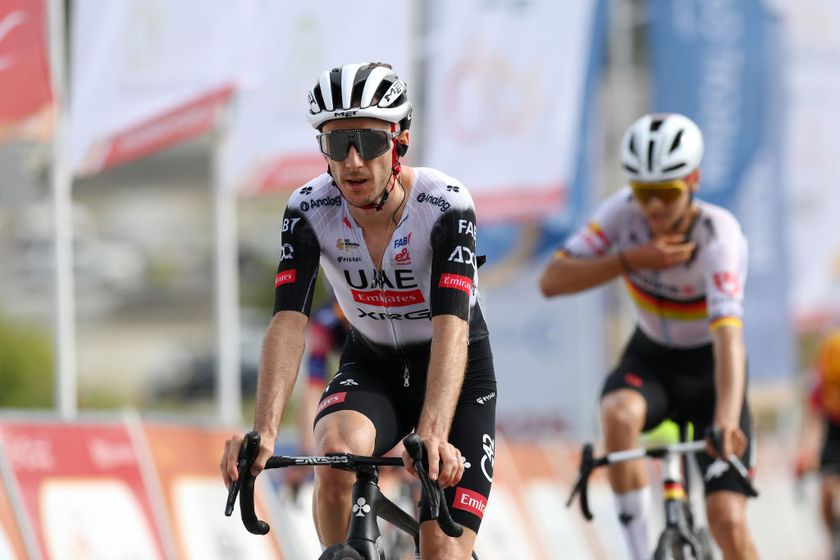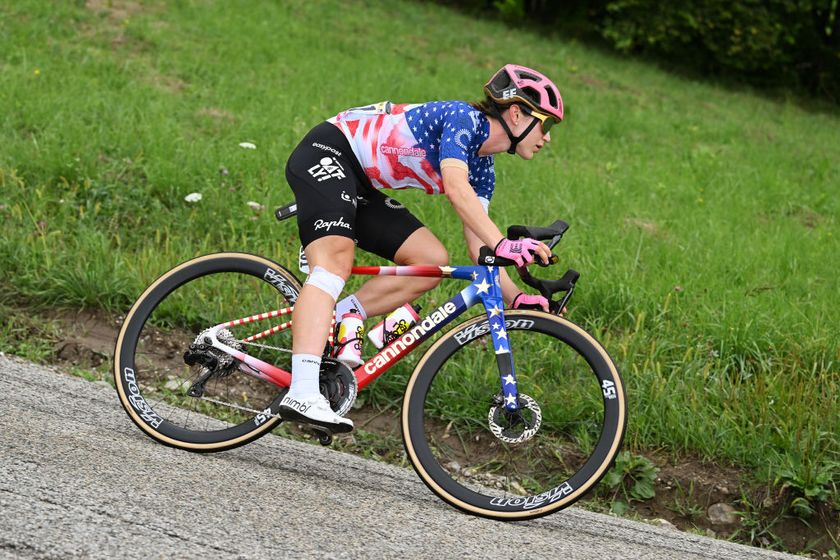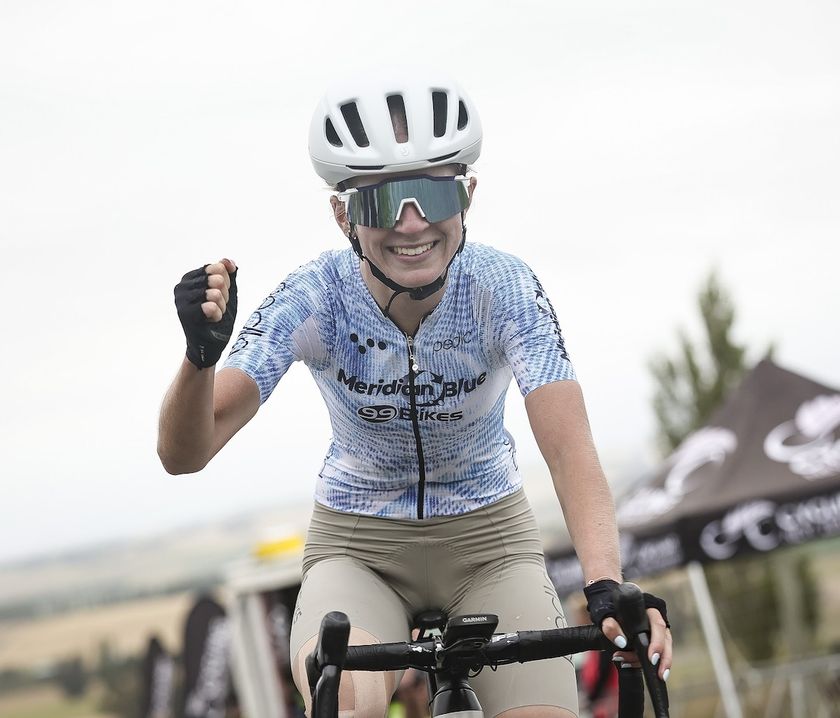The top 10 World road races
A retrospective from Hinault to Armstrong





With the time trials now over, the world championships now enter the second phase of competition with the road races. To mark this, Cyclingnews has put together a retrospective of some of the most hard fought and spectacular world championships in the history of the event. From the modern era with Cadel Evans' solo victory in Mendrisio, to the 1950's with legendary sprinter Rik Van Steenbergen's 1956 Copenhagen triumph, and even earlier with the pioneer of road cycling, Alfredo Binda. Check out Cyclingnews' full top ten below.
1. Bernard Hinault 1980
The course for the 1980 Worlds at Sallanches in the French Alps was widely viewed as the toughest of all time. Comprising 20 laps and 20 ascents of the Domency climb, it had been set up for Bernard Hinault. Jacques Anquetil declared it so tough that only 15 riders would finish
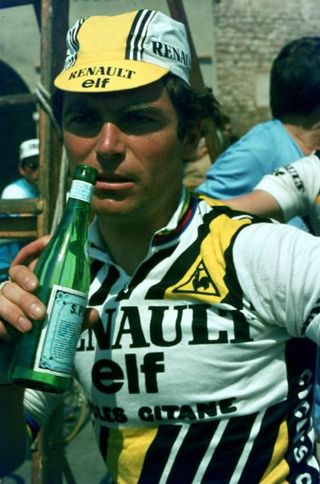
The French legend was spot on. Going into the race there were huge doubts about Hinault’s fitness after his abandon from the Tour de France due to tendonitis, but “The Badger” proved to be as good as his word when he told his rivals not to bother putting any champagne on ice. His attack produced the first selection, leaving him with just four rivals: Italy’s Baronchelli, Denmark’s Marcussen, Belgium’s Pollentier and Britain’s Robert Millar. As Hinault continued to press, Pollentier yielded, then Marcussen, then, with two laps remaining, Millar slipped back. Baronchelli was the last to fall away as Hinault finished more than a minute clear, with Spain’s Juan Fernández more than four minutes back in third.
2. Eddy Merckx 1974
Only two riders have ever won the Giro, Tour and world titles in the same year and, not too surprisingly, one of them was the great Eddy Merckx. The 1974 race, held in Montreal, was the first to take place outside Europe and came two years before the Canadian city hosted the Olympic Games. With the Belgian team all working for him, and notably his long-time team-mate Jos Bruyère, Merckx went into the final lap with just three other riders to worry about: Italy’s Giacinto Santambrogio and French duo Raymond Poulidor and Mariano Martinez.
Fearing that Santambrogio might have the edge on him in a sprint, Merckx launched a fierce attack with 5km remaining and only 38-year-old veteran Poulidor was able to stay with him. Coming into the finish there was only ever likely to be one winner as “The Cannibal” and cycling’s most renowned runner-up faced off, and Merckx took the verdict easily, adding his name to the rank of three-time Worlds winners.
3. Fausto Coppi 1953
By 1953 Fausto Coppi had won almost every major title in the sport, but the world championship still eluded him. That year’s course in Lugano suited his climbing talents perfectly, but to improve his chances even further Coppi told Italian selector Alfredo Binda he would only ride if Gino Bartali was not selected. Binda agreed to Coppi’s request and was rewarded with one of the most outstanding individual performances in world road race history.
A devastating attack on the Crespera climb on the 12th of 20 laps saw Coppi drop all of his rivals apart from Germain Derijcke. The dogged Belgian hung on to Coppi’s wheel for another 75km but when Coppi accelerated once again on the Crespera, Derijcke could not respond. Coppi went on to win by six minutes and was famously greeted on the line by Giulia Occhini, the “white lady” with whom Coppi was having a relationship that was set to scandalise Italy.
Get The Leadout Newsletter
The latest race content, interviews, features, reviews and expert buying guides, direct to your inbox!
4. Abraham Olano 1995
The only World Championship ever to take place in Colombia was undoubtedly one of the toughest of all time. The race had been set up as a head-to-head between Miguel Induráin and Marco Pantani.
The Spaniard left nothing to chance in his preparations for the race on the Duitama course where the key climb topped out at 2850m. He spent the month before the race preparing at altitude in Colorado with several team-mates. Abraham Olano was not among them, as he was riding the Vuelta, where he won all three time trials and went straight to Colombia with his focus on the time trial crown. Olano took silver behind Induráin in the TT, but surprised everyone by reversing those positions in the road race. The Spanish tactic was for Fernando Escartín and Olano to soften up the strong Italian and Swiss teams with attacks late on in the race, after which Induráin would make his move.
Escartín attacked with four laps to go, but was brought back. With Induráin very tightly marked, Olano jumped clear with 14km remaining. With everyone watching Induráin, Olano forged clear, gaining 40 seconds, but on the climb Pantani opened up, cutting his advantage back to 16 seconds with 6km remaining. The Italian, though, could not shake Induráin and his pursuit of Olano faltered. The Spaniard edged away once again, his only nervous moment coming when he punctured with 1800m to the line. He rode in on a flat tubular, nervously raising one arm to celebrate Spain’s first world title, while Induráin pipped Pantani for second.
5. Benoni Beheyt 1963/Maurizio Fondriest 1988
By a quirk of fate two of the most controversial world road races have taken place in the Belgian town of Ronse. On both occasions the race ended in bitterness for the Belgian favourite. In 1963, the home team were riding for Rik Van Looy, winner of the title in 1960 and 1961 and looking well set for a third success with six team-mates alongside him in the leading group of 29. However, 22-year-old Benoni Beheyt felt he was stronger than Van Looy and made his own move when the final sprint was launched.
As Beheyt passed his team leader, Van Looy tried to force him into the barriers. Beheyt responded with a shove on Van Looy’s saddle and surged ahead to claim the title. The contrasting expressions of the two Belgians on the podium spoke volumes. As Beheyt celebrated, Van Looy was stoney-faced. Twenty-five years on, and there were recriminations once again after Canada’s Steve Bauer and Belgium’s Claude Criquielion tangled in the run-up to the line.
Sensing a space to pass Bauer along the barriers, Criquielion made his move, but as he did so Bauer inadvertently moved to the right, sending the Belgian tumbling and opening the door to Italy’s Maurizio Fondriest, who sailed home. The dispute between Criquielion and Bauer rumbled for years, with the Belgian eventually taking legal action in the courts, only to lose the case to the Canadian.
6. Cadel Evans 2009
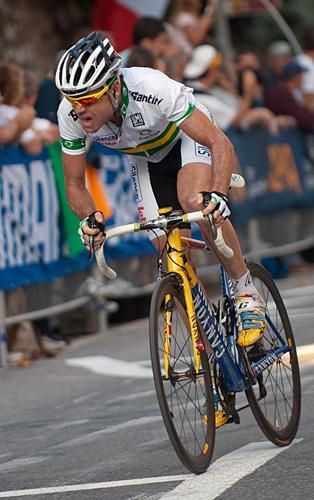
Everything pointed towards Fabian Cancellara becoming the first rider in history to complete the road and time trial double at the Worlds. Riding on home ground at Mendrisio, the Swiss was unstoppable in the time trial and looked equally strong going into the closing stages of the road race. On the penultimate lap he made his move, but after splitting the field found himself closely marked by four Spanish riders.
On the final lap Cancellara went again and this time only Samuel Sánchez could follow, but the Olympic champion refused to work with the Swiss and a nine-man group formed, with the four Spaniards dominating it. Joaquim Rodríguez was the first of them to make move just before the final ascent. He was quickly followed by Russia’s Alexandr Kolobnev. Sensing that no one else was going to chase, Evans jumped across to Kolobnev, and these two moved up to Rodríguez. At the foot of the final climb, Evans launched his attack, dropping Kolobnev and Rodríguez and soloing away to a victory on which he has subsequently built with a series of career-defining successes.
7. Alfredo Binda 1932
Winner of the first world road championship at Germany’s Nurburgring in 1927, Italy’s Alfredo Binda became the first man to claim three world titles when he won the 1932 race in Rome. Binda’s principal rivals during this period came from within his own team. As has been the case in more recent times, other riders profited from splits within the Italian ranks, notably Belgium’s Georges Ronsse, who took the world crown in 1928 and 1929. However, with Italian dictator Benito Mussolini insisting on a home victor, the Italians dominated the race in Rome that took place over three laps of a punishing 68km circuit.
Legend has it that Mussolini wanted Binda’s rival Learco Guerra to take the title, apparently because Guerra’s name appealed more to Il Duce, but Guerra didn’t feature as Binda and team-mate Remo Bertoni rode away to dispute the title between them. Luxembourg’s Nicolas Frantz came in almost five minutes down on the two untouchable Italians to take the bronze medal.
8. Oscar Freire 1999
Spanish selector Paco Antequera was hugely criticised when he picked an injury-hit second-year pro with just one win to his credit and 18 days of racing under his belt in 1999 for that year’s World Championships in Verona.
Viewed very much as a sprinter, Oscar Freire felt that the tough circuit suited him, although he didn’t believe he had much chance of contending for the podium. Jan Ullrich was the favourite, and it was the German who instigated the winning break with an attack on the final ascent of the Torricelle climb. Francesco Casagrange and Frank Vandenbroucke, who had broken in a wrist in an earlier crash, went with the German, and on the descent half a dozen more riders got across to the leading trio.
As the least experienced, it seems Freire was discounted by his rivals, particularly after the Spaniard’s late attack with defending champion Oscar Camenzind had been neutralised. Going into the final kilometre, Freire dropped to the back of the line, waiting for the sprint, but with 500m left he decided to surprise his more experienced rivals with another attack. As Ullrich and co waited for each other to respond, Freire sped clear to the first of his three world titles.
9. Rik Van Steenbergen 1956
The second of four riders to win three rainbow jerseys, Rik Van Steenbergen was the victor the last time the Worlds took place in Denmark in 1956. They took place in the Copenhagen suburb of Ballerup, not far from where “Rik I” had taken his first world title in 1949, when he outsprinted Ferdi Kübler and Fausto Coppi. Seven years on, Van Steenbergen, one of the best sprinters of all time, was one of a 10-man group vying for the title.
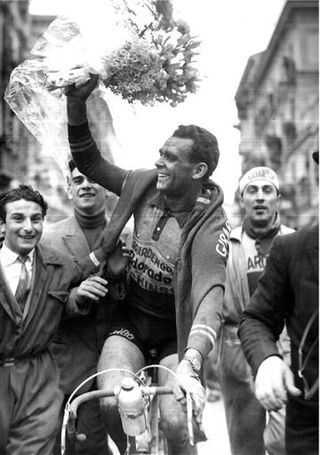
Among them was his Belgian team-mate and quickly emerging rival, Rik “Rik II” Van Looy, as well as three other Belgian riders. By no means certain that Van Looy would yield to him in the final dash, 34-year-old Van Steenbergen launched his sprint early and hung on to beat Van Looy, with Holland’s Gerrit Schulte in third. Van Steenbergen completed his hat-trick on home ground at Waregem the following year.
10. Lance Armstrong 1993
Although a winner of a stage at the Tour de France earlier that summer and already the American road champion, Lance Armstrong was viewed as an outsider when the Worlds went to Oslo in 1993. As would be the case in Colombia two years later, Miguel Induráin was very much the favourite, but the atrocious conditions made the race more unpredictable as the Spanish team struggled to contain their rivals. Having forced an initial selection during the latter stages of the race, Induráin led the chase up to three breakaway riders on the final ascent of the Ryenberg. As the group reached Olaf Ludwig, Dag-Otto Lauritzen and Frans Maassen, Armstrong countered.
Induráin and the other big names may have believed they would catch the 22-year-old American on the descent, but Armstrong showed he had the handling skills to match any of them as he defied to treacherous roads to finish 19 seconds ahead of Induráin and Ludwig.
Peter Cossins has written about professional cycling since 1993 and is a contributing editor to Procycling. He is the author of The Monuments: The Grit and the Glory of Cycling's Greatest One-Day Races (Bloomsbury, March 2014) and has translated Christophe Bassons' autobiography, A Clean Break (Bloomsbury, July 2014).
